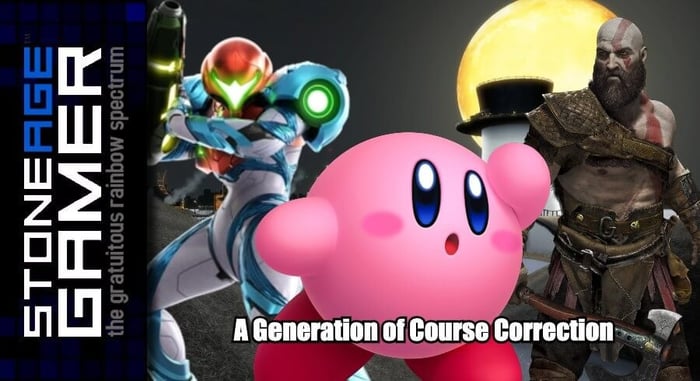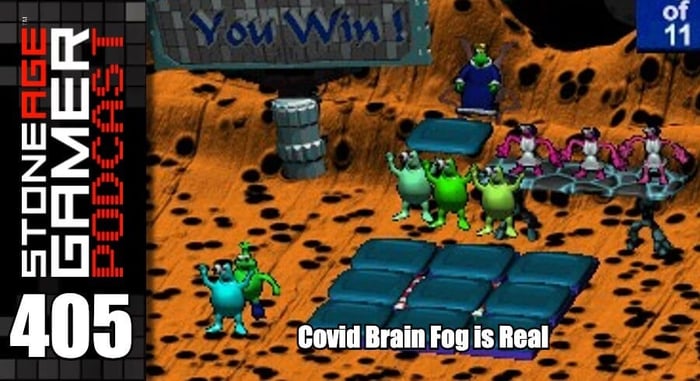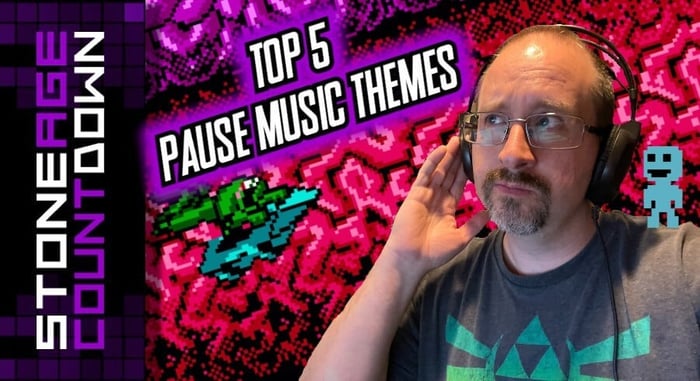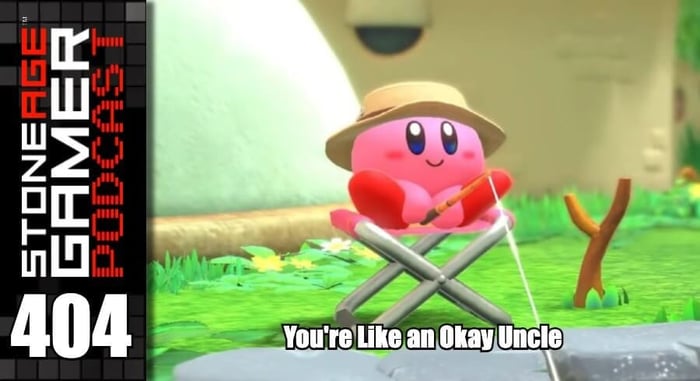
A Generation of Course Correction
This has been quite a generation for video games. There’s been plenty of negatives to be sure, but one thing I’ve noticed a lot lately is long running franchises pulling successful course corrections. As a Nintendo fan, I’ve noticed this more on Switch than on other platforms, but it isn’t a strictly Nintendo thing. Everybody’s been getting in on the action of figuring out why their big name games worked in the first place and churning out successful new iterations that please fans and critics alike.
Return to Roundness
Take Kirby for example. I haven’t exactly been a Kirby fan for a number of years, but I was a huge Kirby fan when the series started on Game Boy. The original Dream Land was such a fun little game that I was more than happy to pick up anything that followed with Kirby’s name on it. When Adventure hit on NES, I was hooked, and I continued to enjoy Kirby’s subsequent adventures almost all the way through the Super NES era. I fell off around Kirby 64 though. A few others that came after were still pretty good, and the weird offshoots like Epic Yarn and Dream Course were a good time, but when it came to 2D platformers, Kirby had fallen into a bit of a rut, which was made all the more clear with the lackluster Star Allies.

Then Kirby and the Forgotten Land hit Switch. It’s ambitious, clever, and clearly bursting at the seams with love and care. It’s an extraordinary game that gets to the core of why Kirby worked in the first place, and runs with it. It’s also the first proper 3D Kirby game, and they made the transition seamlessly. It’s just a wonderful little game.
Linking to the Past
The Zelda series has had an amazing run since its inception. However, following the generation-defining Ocarina of Time, Nintendo began to struggle with exactly what to do with the series. Majora’s Mask was all kinds of weird, Wind Waker featured a very divisive art style, Twilight Princess was massive but empty, and it all came to a head in Skyward Sword, a charming adventure that relies on spotty motion controls, linear design, and a ton of backtracking. The mainline Zelda games were never outright bad, and occasionally they were even brilliant, but nothing matched Ocarina in terms of fan response.

Then Breath of the Wild took Zelda all the way back to its roots in a modern way. Like the NES original, it’s completely open, and does everything it can to encourage experimentation and exploration. It’s an open world game that even people who don’t like open world games can enjoy. It was still flawed, especially with its overly fragile weapons, but it was a massive success that people are still talking about today.
A Much More Super Fighting Robot
Mega Man 11 wasn’t a global blockbuster, but it did a lot more heavy lifting in terms of bringing the mainline Mega Man games to a cohesive place to build on than it gets credit for. Mega Man 1-6 evolved at a somewhat steady pace on NES, but the core of the game was always the same. Mega Man 7 continued that trend by expanding on 6’s branching paths and of course modernizing the graphics, while Mega Man 8 took the exploratory stage setup arguably too far, while also featuring all the modern trappings the PlayStation and Saturn could boast including animated cutscenes, voice acting, and a striking animated visual style.
Then the faux 8-bit Mega Man 9 happened, and while it was brilliant, an unfortunate side effect was that it also stunted Mega Man’s growth as a series.

Mega Man 11 had to re-evole Mega Man in a way that felt natural after both Mega Man 8 and Mega Man 10. Fortunately for us all, it pulled it off. Sure it could have been a bit more ambitious, but its somewhat reserved approach made sense following the series unorthodox trajectory to that point. Like I said, Mega Man 11 deserves a lot more credit than it gets.
Restart the Fight
I’ll admit that I don't know a whole lot about Halo, but I have paid enough attention to more or less follow its trends. Despite the fact that I thought Master Chief had a remarkably lazy and derivative character design (and a pretty stupid name) Halo has endured, and even thrived for over 20 years.
That said, it’s my understanding that Halo games started falling off in overall likability in the last several years, with Reach being the last game I remember feeling like an “event” when it was released. Halo 4 and 5 reviewed fine, but it seemed to feel like they just kind of came and went.

Then Halo Infinite came out and things seemed to have changed. On paper it doesn’t look like Infinite has performed all that much better than 5 did, but the general word of mouth has really been something. The excitement to play it was palpable all over the internet, and that the complaints people had about the previous couple of Halo games had theoretically been addressed in meaningful ways. Halo was always cool, but it was genuinely fun to play again. What more could you want?
See You Next Mission
Metroid’s had it rough for a while, but only in terms of actual sales. In terms of game quality, Metroid is one of the best darn brands out there. Once the Wii came out though, things started to turn for Samus. Prime 3 was a great game, but it didn’t move the needle the way the original Prime did. And then it was followed up by the unmitigated disaster that was Other M and Metroid fell into darkness for a good long time. The next game to release in the Metroid series was Federation Force, a chibi squad based shooter for 3DS that barely even featured Samus at all. People hated it.

Metroid Dread nailed it though. I guess this is technically a cheat because Samus Returns laid some excellent groundwork on 3DS a few years prior, but it never gained anywhere near the traction Dread did. It became a frequent hot topic of conversation online, and its sales numbers currently have it sitting just behind Metroid Prime as the best selling game in the franchise. That's a pretty big deal. Metroid Prime 4 has a lot to live up to, and if it can deliver, there will be no doubt that Metroid has graduated to become one of Nintendo’s top tier franchises.
A “BOY” and his God
Much like a couple of the other games on this list, there hasn’t been a “bad” God of War game. However, before the utterly brilliant God of War hit the PlayStation 4 in 2018, the formula that got the series where it was had become a bit long in the tooth. God of War’s combat and cinematics were a revelation back when the first game hit, but even when God of War III hit PalyStation 3 with resounding success, you could start to hear voices asking if the series could continue without some sort of major reinvention.

Thankfully, God of War for PlayStation 4 gave the series exactly what it needed at exactly the right time. It basically played like a franchise reboot while still being tied to the games that preceded it, and it earned numerous accolades because of it. If its upcoming sequel follows suit, there’s no doubt God of War is set to maintain a path of excellence for years to come.
Starting at Zero
A niche franchise to pretty much everyone but me, Blaster Master is a legendary NES game for a reason. Its sequels, on the other hand, vary in quality greatly. They all tried, but none managed to actually advance the series in a meaningful way, or live up to the original.
Then the folks at Inti Creates got a hold of the license and did what Mega Man 9 failed to do. It recaptured the brilliance of the most popular 8-bit entry while simultaneously moving the series forward.

Blaster Master Zero was a work of genius, and its two sequels gave fans something they had never gotten before, a proper evolution of the basic Blaster Master formula. All three Blaster Master Zero games were great, and with any luck if there are more Blaster Master games in the future, they can finally move beyond their 8-bit inspired roots and become something truly modern.
It’s-a-Me!
3D Mario games haven’t really been a thing since Super Mario Sunshine. The Galaxy games and 3D Land/World are all their own thing. 64 and Sunshine are the only two proper 3D Mario adventures, and a lot of folks felt Sunshine dropped the ball.
Years later, Nintendo took another swing at true 3D Mario with Odyssey and it was nothing short of a masterpiece, effectively fixing everything 64 and Sunshine did wrong while bringing a ton of fresh ideas to the table. Bowser’s Fury was equally as impressive, though for different reasons. Now if only they’d release a new 2D Mario game with that level of love and care.

Spinoffs have fared well too. Mario Party, Mario Golf, and Mario Tennis have all had solid new entries that have moved their respective franchises forward. Party and Tennis in particular were coming from a pretty bad place, and their newest entries may not be perfect, but they’re a heck of a lot better than what came before.
It’s an exciting time for games, and while other big names remain in the lurch, for every Contra: Rogue Corps there’s a Sonic Mania, and in an industry that’s sometimes known for its stifling of creativity, fresh takes on old ideas are always nice to see.





